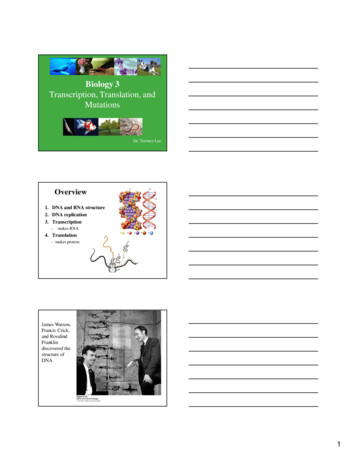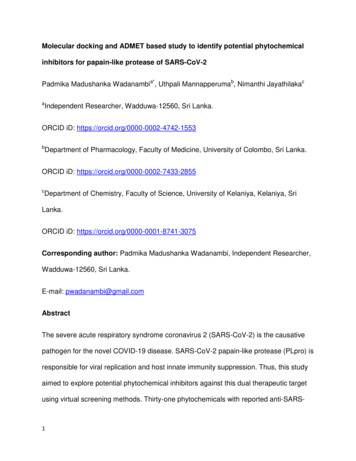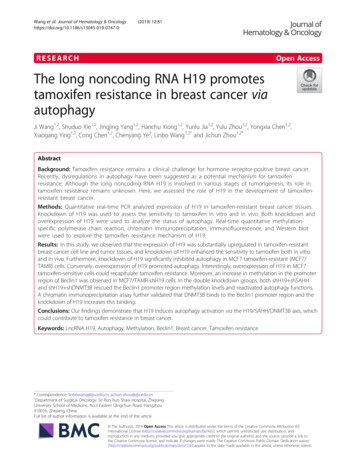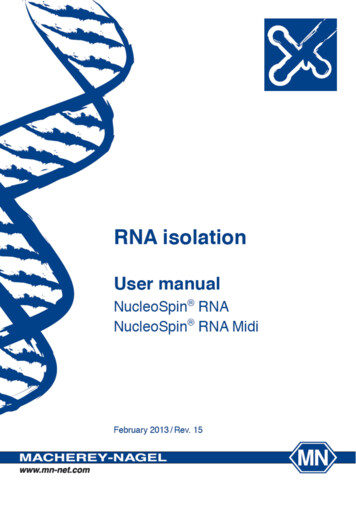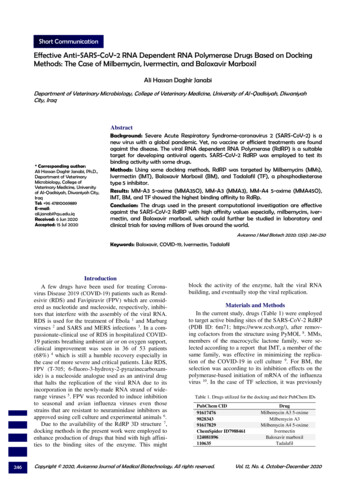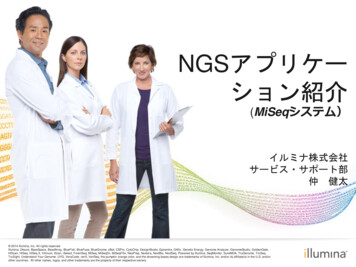
Transcription
SARS-CoV-2 RNA, Qualitative Real-Time RT-PCR (Test Code 39433)Package InsertFor Emergency Use OnlyFor In-vitro Diagnostic Use - Rx OnlyIntended UseThe Quest Diagnostics SARS-CoV-2 RNA, Qualitative Real-Time RT-PCR (“Quest SARS-CoV-2 rRT-PCR”) is a real-timeRT-PCR test intended for the qualitative detection of nucleic acid from the SARS-CoV-2 in upper and lower respiratoryspecimens (such as nasopharyngeal or oropharyngeal swabs, sputum, tracheal aspirates, and bronchoalveolar lavage)collected from individuals suspected of COVID-19 by their healthcare provider.This test is also for use with nasal swab specimens that are self-collected at home or in a healthcare setting by individualsusing an authorized home-collection kit when determined to be appropriate by a healthcare provider.This test is for the qualitative detection of nucleic acid from the SARS-CoV-2 in pooled samples containing up to four ofthe individual upper respiratory swab specimens (nasopharyngeal, mid-turbinate, anterior nares or oropharyngeal swabs)that were collected in individual vials containing transport media from individuals suspected of COVID-19 by theirhealthcare provider. Negative results from pooled testing should not be treated as definitive. If patient’s clinical signs andsymptoms are inconsistent with a negative result or results are necessary for patient management, then the patient shouldbe considered for individual testing. Specimens included in pools with a positive, inconclusive, or invalid result must betested individually prior to reporting a result. Specimens with low viral loads may not be detected in sample pools due tothe decreased sensitivity of pooled testing.Results are for the identification of SARS-CoV-2 RNA. The SARS-CoV-2 RNA is generally detectable in respiratoryspecimens during the acute phase of infection. Positive results are indicative of the presence of SARS-CoV-2 RNA; clinicalcorrelation with patient history and other diagnostic information is necessary to determine patient infection status. Positiveresults do not rule out bacterial infection or co-infection with other viruses. The agent detected may not be the definite causeof disease. Laboratories within the United States and its territories are required to report all positive results to the appropriatepublic health authorities.Negative results do not preclude SARS-CoV-2 infection and should not be used as the sole basis for treatment or otherpatient management decisions. Negative results must be combined with clinical observations, patient history, andepidemiological information. Specimens that are self-collected will not be tested with an internal control to confirm that thespecimen was properly collected. Self-collected specimens from SARS-CoV-2 positive individuals may yield negativeresults if the specimen was not collected properly.Testing is limited to laboratories designated by Quest Diagnostics that are certified under the Clinical LaboratoryImprovement Amendments of 1988 (CLIA), 42 U.S.C. § 263a, and meet the requirements to perform high complexity tests.Testing with the SARS-CoV-2 rRT-PCR test is intended for use by qualified and trained laboratory personnel specificallyinstructed and trained in the techniques of real-time RT-PCR assays. The SARS-CoV-2 rRT-PCR test is only for use undera Food and Drug Administration’s Emergency Use Authorization.Summary and ExplanationAn outbreak of pneumonia of unknown etiology in Wuhan City, Hubei Province, China was initially reported to WHO onDecember 31, 2019. Chinese authorities identified a novel coronavirus (SARS-CoV-2), which has resulted in thousands ofconfirmed human infections in multiple provinces throughout China and exported cases in several Southeast Asiancountries and more recently in Europe and the United States. Cases of severe illness and some deaths have been reported.1
The Quest Diagnostics SARS-CoV-2 RNA, Qualitative Real-Time RT-PCR aids in the detection of SARS-CoV-2 RNA anddiagnosis COVID-19 and is a real-time reverse transcription polymerase chain reaction test. The test’s primer and probesets were designed to detect RNA from individuals suspected of COVID-19 by their healthcare provider. Testing is limitedto Quest Diagnostics laboratories in San Juan Capistrano CA, Chantilly VA, and Marlboro MA, or other laboratoriesdesignated by Quest Laboratories that are also certified under the Clinical Laboratory Improvement Amendments of 1988(CLIA), 42 U.S.C. §263a, to perform high complexity tests.In sample pooling, specimens are identified from populations based on positivity rate (for example, by county, zip code orby client), and up to four patient specimens are combined into a pool, and the pool is tested as described in this packageinsert. If the pool is positive or inconclusive or invalid, then each of the constituent samples is re-tested as a separateindividual specimen. If the pool is negative, then each constituent sample is reported as negative.Principles of the ProcedureThe test is a real-time RT-PCR test intended for the qualitative detection of nucleic acid from the SARS-CoV-2 in upperrespiratory specimens (for example, nasopharyngeal swabs, oropharyngeal swabs, sputum, BAL, and tracheal aspirates).The assay is composed of two principal steps: (1) extraction of RNA from patient specimens, (2) one-step reversetranscription and PCR amplification with SARS-CoV-2 specific primers and real-time detection with 2019-nCoV specificprobes. The assay targets regions of the virus nucleocapsid gene (N1 & N3) and is designed for the detection of SARSCoV-2. Amplification and detection are accomplished using TaqMan chemistry on the ABI 7500. To ensure the absence ofnon-specific PCR inhibition of a sample, an internal positive amplification control (IPC) is included with each specimen. Asample can be interpreted as negative only if the analysis of the IPC indicates that amplification has occurred in the reactiontube but no signal from target reporter dye has been detected. Detection of viral RNA not only aids in the diagnosis of illnessbut also provides epidemiological and surveillance information.Materials Required (Provided) MagnaPure Extraction MagNA Pure 96 DNA and Viral NA – Small Volume Kit Roche Diagnostics #06 543 588 001 (3 x 192isolations) MagNA Pure 96 External Lysis Buffer or other comparable lysis buffer that will be validated Omega Extraction Mag-Bind Viral RNA Xpress Kit (Omega Bio-Tek, Cat. M6219-2304) 4X 1-Step RT-qPCR Master Mix, CG Exogenous NA Primer Pair Exogenous NA1 TE Buffer, pH 8.0 Quest V-C-M transport medium, Quest PBS Specimen Transport Tubes or other comparable transport mediumthat will be validated Poly (A) DEPC-water PBS, 1X DTTReagents:nCoV RT-PCR Mix Primers and Probes2019-nCoV N1 Forward Primer2019-nCoV N1 Reverse Primer2
2019-nCoV N1 Probe2019-nCoV N3 Forward Primer2019-nCoV N3 Reverse Primer2019-nCoV N3 ProbeReagent Preparation and StoragePrimer and Probe 10µM stocks in TE BufferDilute Probes 100 µM stocks 1:10 in TE Buffer ex: 100 µL 900 µL TE Buffer). Prepare aliquots in screw cap tubes.Dilute Primers 200 µM stocks 1:10 in TE Buffer ex: 50 µL 950 µL TE Buffer). Prepare aliquots in screw cap tubes.Storage Store @ -60ºC to -90ºCStability 1 year from date of preparation.Formulation sheet EFORM.129. 014804x RT-PCR enzyme mix 1 mL aliquotsThaw / equilibrate 10mL bottle(s) of 4x RT-PCR enzyme mix to room temperature (protect from light). Mix bottle contentsthoroughly by inversion and gentle swirling. Transfer 1.0 mL aliquots of mix to pre-labeled sterile screw cap tubes.Storage Store @ -60ºC to -30ºCStability as specified by manufacturer on bottle5 mg/mL poly (A)Dissolve 100 mg of poly (A) in 20 mL of DEPC-water in a 50 mL sterile centrifuge tube. Vortex until completelydissolved. Prepare 1 mL aliquots in screw cap tubes.Storage Store @ -60ºC to -90ºCStability 2 years from date of preparation.RNA Diluent PAdd 1 mL of 5 mg/mL poly (A) to 1 x 500 mL bottle of 1x PBS (new, unopened, without CA, Mg salts). Mix well. Prepare40 mL aliquots in 50 mL sterile centrifuge tubes. The final concentration of poly (A) is 10 µg/mL.1In the event that a RNA internal process control is temporarily unavailable, a DNA internal process control, exhibitingsimilar PCR performance, may be used temporarily.3
DTT solution 500mMAdd 100 µL of nuclease free water to one microtube containing DTT and mix with pipette tip. Add the entire 100µL DTTsolution into 5mL of cold sterile 0.01 M PBS (pH 7.2) and mix briefly. Discard any unused reconstituted DTTSARS-CoV-2 PCR MixCombine the ingredients in the amounts listed below.Dispense in 455 µL aliquots label as: NCOV PCR MixLot#/Prep: (preparation date. initials)Exp. date: (1 year from preparation date)Store at -60 to -90 CEach aliquot is sufficient for up to 48 reactions.Storage Store at -60 to -90 C.Stability Expires 1 year after preparation.See Formulation Sheet EFORM.129.001481.ItemSterile Nuclease Free Water2019-nCoV N1 Forward Primer (10 µM in TE, pH 8.0)2019-nCoV N1 Reverse Primer (10 µM in TE, pH 8.0)2019-nCoV N1 Probe (10 µM in TE, pH 8.0)2019-nCoV N3 Forward Primer (10 µM in TE, pH 8.0)2019-nCoV N3 Reverse Primer (10 µM in TE, pH 8.0)2019-nCoV N3 Probe (10 µM in TE, pH 8.0)50X Exogenous NA Primer/Probe MixTotalµL perreaction3.751.001.000.251.001.000.250.508.750 µLUnit of Measurefor 1,000 reactions3.75 mL1.00 mL1.00 mL0.25 mL1.0 mL1.0 mL0.25 mL0.50 mL8.750 mLFinal Concentrationper 25 µL reaction--0.4 µM0.4 µM0.1 µM0.4 µM0.4 µM0.1 µM1XEquipment and Supplies Applied Biosystems 7500 Real Time PCR System (or ABI 7500 fast system run as a standard ABI 7500)Roche MagNA Pure 96 System (MagnaPure extraction)Hamilton MagEx STAR (Omega extraction)Bench-top centrifugeSerological Pipet (Pipette Aid)Sterile screw cap 15 mL conical tubesSterile screw cap 50 mL conical tubesP10, P20, P200, P1000 pipettesP-10, P-20, P-200, P-1000 ART Plugged Tips1.5 mL or 2 mL microcentrifuge tubesMetal tubesStandard absorbent wipesLatex gloves and other protective equipment (see Procedure)Biohazard Absorbent Wipes96-Well Optical Reaction PlateOptical Adhesive CoverVortexerMicrocentrifugeSelf-collection KitsQuest Diagnostics Self-collection kit for COVID-19Warnings and Precautions1. For in vitro diagnostic use (IVD).2. This test has not been FDA cleared or approved; the test has been authorized by FDA under an Emergency Use4
3.4.5.6.7.8.9.10.Authorization (EUA) for use in laboratories designated by Quest Diagnostics that are also certified under CLIA, and meetthe requirements to perform high complexity tests.This test has been authorized only for the detection of nucleic acid from SARS-CoV-2, not for any other viruses orpathogensThis test is only authorized for the duration of the declaration that circumstances exist justifying the authorization ofemergency use of in vitro diagnostics for detection and/or diagnosis of COVID-19 under Section 564(b)(1) of the FederalFood, Drug and Cosmetic Act, 21 U.S.C. § 360bbb-3(b)(1), unless the authorization is terminated or revoked sooner.Follow standard precautions. All patient specimens and positive controls should be considered potentially infectiousand handled accordingly.Do not eat, drink, smoke, apply cosmetics or handle contact lenses in areas where reagents and human specimens arehandled.Handle all specimens as if infectious using safe laboratory procedures. Refer to Interim Laboratory Biosafety Guidelinesfor Handling and Processing Specimens Associated with 2019-nCoV fety-guidelines.html.Specimen processing should be performed in accordance with national biological safety regulations.If infection with SARS-CoV-2 is suspected based on current clinical and epidemiological screening criteriarecommended by public health authorities, specimens should be collected with appropriate infection control precautions.Performance characteristics have been determined with human upper respiratory specimens and lower respiratory tractspecimens from human patients submitted for respiratory infection testing (and presumed to have signs and symptomsof disease).Specimen Collection, Handling, and StorageInadequate or inappropriate specimen collection, storage, and transport are likely to yield false test results. Training inspecimen collection is highly recommended due to the importance of specimen quality. CLSI MM13-A may be referencedas an appropriate resource. Collecting the Specimeno Refer to Interim Guidelines for Collecting, Handling, and Testing Clinical Specimens from Patients UnderInvestigation (PUIs) for 2019 Novel Coronavirus (2019-nCoV) s-clinical-specimens.htmlo Follow specimen collection device manufacturer instructions for proper collection methods.o Swab specimens should be collected using only swabs with a synthetic tip, such as nylon or Dacron , and analuminum or plastic shaft. Calcium alginate swabs are unacceptable and cotton swabs with wooden shafts arenot recommended. Place swabs immediately into sterile tubes containing 1-3 ml of viral transport media (orPBS or saline if better alternatives are not available) Transporting Specimenso Specimens must be packaged, shipped, and transported according to the current edition of the International AirTransport Association (IATA) Dangerous Goods Regulation. Follow shipping regulations for UN 3373 BiologicalSubstance, Category B when sending potential 2019-nCoV specimens. Store specimens at 2-8 C and shipovernight on ice pack. If a specimen is frozen at -70 C or lower, ship overnight on dry ice Storing Specimenso Specimen stability after collection: 14 days at 18 C to 25 C, 14 days at 2 C to 8 C, 14 days at -10 C to -30 C,or at -70 C or lower.ooIf a delay in extraction is expected, store specimens at -70 C or lower.Extracted nucleic acid should be stored at -70 C or lower.Inspection of Returned Unobserved Self-Collection SpecimensSpecimens that are received through the self-collection program are checked for the following criteria before entering thework flow (according to the lab’s SOP):Are the following items present? Swab in the collection tubeTest requisition with patient name and a second identifierTube label with patient name and a second identifierCollection tube that has not leaked5
Is the specimen acceptable? The specimen is within stability criteria.There is enough specimen in the collection tube.The patient name and second identifier match the test requisition.6
ProcedureNOTE: For all procedures involving specimens, buttoned lab coats, gloves, and face protection are requiredminimum personal protective equipment. Report all accidents to your supervisor and in accordance with theCompany’s policies and Procedures. When performing pooling, laboratories will monitor sample pooling inaccordance with Attachment 1 – Protocol for Monitoring of Sample Pooling Testing Strategies.SPECIMEN TRANSFER PROCEDURE (to be performed in Extraction Room)1Total nucleic acids (DNA and RNA) are extracted from patient specimens and assay controls using the Roche MagNAPure 96 DNA and Viral NA Small Volume kit and the Roche MagNA Pure 96 System. Refer to PROC.129.01298Nucleic Acid Isolation on the MagNA Pure 96 Instrument for general instructions on using the MagNA Pure 96Instrument.2Decontaminate work area by wiping down work surface and pipettes with 10% bleach. Let soak for 1 minute. Wipedown work surface and pipettes with 70% ethanol and dry with paper towels.3Remove one aliquot of NCOV Positive Control and NCOV Negative Control, from the freezer and let thaw at roomtemperature. Vortex and spin down.4Create MagNA Pure and AB7500 setup maps for the samples to be tested. 94 patient specimens can be run in a singleset-up, along with 2 controls (1 Positive Control and 1 Negative control per batch). Example of a MagNA Pure set-upmap is provided 139475563717987NEGFor viscous samples (sputum and bronchial wash): Performed inside BSC 2a. Add 250 µL of sample to a metal bead tube.b. Add 350 µL PBS to each tube containing viscous specimen.c. Vortex tubes for about 20 seconds, repeat if needed.d. Quick spin to deposit debris in the bottom of the tube.Alternative method:a. Rehydrate Thermo Scientific Pierce DTT (Dithiothreitol by adding 100 µ or nuclease- free water to one microtubecontaining DTT and gently mix with pipette tip to completely dissolve (500mM final concentration).b. Add the entire 100 µL of freshly prepared DTT to 5 mL of cold Sterile 0.01M PBS (pH 7.2) and mix briefly.c. In a microcentrifuge tube, add the diluted DTT solution to an equal volume of specimen (e.g. 250 µL of fresh 500mMDTT solution to 250 µL of sample). Note: Use DTT immediately. Discard any unused reconstituted DTT.d. Incubate at room temperature with intermittent mixing until the sample is liquified (up to 30 minutes).e. Liquefied specimen can be used for downstream nucleic acid extraction.f.For sample pooling, first pipette 250 µL MagNA Pure External Lysis Buffer into the appropriate well of a MagNA Pure96 Processing Cartridge. For sample pooling, add equal amounts of each specimen (for 4 specimens, add 50 µLeach) pipette up and down at least once after each addition (performed in BSC 2). The decision to pool specimensshould be based on the positivity rate of the location. Pooling is permitted for NP, OP, AN and MT swabs. Forlaboratories considering pooling, please see Attachment 1 for monitoring requirementsFor controls and all other patient specimens that are not run in a pool, first pipette 250 µL MagNA Pure External LysisBuffer into the appropriate well of a MagNA Pure 96 Processing Cartridge. Next, add 200 µL of controls and patientspecimens and pooled specimens, mixing by pipette at least once after each addition (performed in BSC 2).Visually check the level of samples and controls in the MagNA Pure cartridge to ensure sample was added to theappropriate wells.Cover the MagNA Pure cartridge with an absorbent wipe and put into a clean biohazard bag then seal beforetransporting to the MagNA Pure 96 instrument.7
MagNA Pure 96 Nucleic Acid Extraction1.2.3.4.56.7.8.9.10.11.12.13.14.15.Refer to PROC.129.01298, Nucleic Acid Isolation on the MagNA Pure 96 Instrument for general instructions onusing the MagNA Pure 96 InstrumentAll of the following steps are performed in the Specimen Preparation Area.Perform beginning of run maintenance on the MagNA Pure 96 instrument (as described in PROC.129.01298).In the Overview tab, select Enter Order, and select “External Lysis 450 µL ”.The following parameters should be loaded:MagNA Pure Kit Name: “DNA/Viral NA SV 2.0”Protocol: “DNA BLOOD EXT LYS SV 3.1”Sample volume: 450 µLElution volume: 50 µLInternal Control should be “IPC”Click on the “ ” button next to the IPC dropdown. Scan the barcode on the vial of internal control. Note the fillvolume (3.1mL) and number of samples in the batch. Set the expiration date.Set the total number of specimens and controls to match the current batch.Save the order to move to next screen.Refer to the software for the correct volumes and placement of the liquid reagents and disposable plasticsupplies. Label the sample elution cartridge with the batch ID.Carefully place the loaded sample cartridge on the MagNA Pure 96 instrument.Confirm proper placement on the screen.Start the run by clicking Start.At the completion of the run cover the sample elution cartridge with an adhesive plate sealer and transfer thecartridge to the PCR set up area if processing immediately (within 30 minutes) or to frozen storage ( -70oC orcolder ) for up to one week.Tips and unused reagents may stay on the system for the next run. Cover reagents with a foil sealing cover if notusing immediately.Perform end of run maintenance on MagNAPure 96 instrument as in PROC.129.01298.8
1.2.3.4.SPECIMEN TRANSFER PROCEDURE for the Omega Method using the HAMILTON STAR(to be performed in Extraction Room)Total nucleic acids (DNA and RNA) are extracted from patient specimens and assay controls using theMag-Bind Viral RNA Xpress Kit (Omega Bio-Tek) on the Hamilton MagEx STAR Autoload automatedplatform.Refer to PROC.129.01744- Hamilton MagEx STAR Autoload System Use and Maintenance for generalinstructions on using the Hamilton STAR.Decontaminate work area by wiping down work surface and pipettes with 10% bleach. Let soak for 1minute. Wipe down work surface and pipettes with 70% ethanol and dry with paper towels.Remove one aliquot of NCOV Positive Control and NCOV Negative Control from the freezer and letthaw at room temperature. Vortex and spin down.Create Hamilton and AB7500 setup maps for the samples to be tested. For example: 94 patientspecimens can be run in a single set-up, along with 2 controls (1 Positive Control, 1 Negative, and 94patient specimens per 96 17987NegAPosBC2Rotating positional control based on the load number will be used for specific identification of theextraction plate and prevention of plate switch. Refer to additional preventive measures onPROC.129.01038 and PROC.129.016115.6.7.8For controls and upper respiratory patient specimens, pipette 240 uL Hamilton Lysis Buffer followedby 200 uL of specimen into the appropriate well of a Hamilton deep well plate.Note: The Hamilton is not for use with Sputum or BAL specimens.Visually check the level of samples and controls in the deep well plate to ensure sample was added tothe appropriate wells.Cover the deep well plate with an absorbent wipe and put into a clean biohazard bag then seal beforetransporting to the Hamilton STAR.Label the load name on the extraction and output to each corresponding plate that will be loaded on theHamiltonCheck the position of the corresponding plates on the Hamilton deck.9
Omega Method using the Hamilton STAR Nucleic Acid Isolation1.2.3.4.5.6.7.89.10.11.Refer to PROC.129.01744, Hamilton MagEx STAR Autoload System Use and Maintenance for generalinstructions on using the Hamilton STAR.All of the following steps are performed in the Specimen Preparation Area.Perform daily maintenance on the Hamilton instrument.In the Method Launcher desktop application located on the desktop, click on the “Omega extraction”tab, and select the number of plates to be run (up to 4 plates). If a partial plate is run, the instrument willprocess as full.Refer to the software for the correct volumes and placement of the liquid reagents and disposableplastic supplies. Label the sample elution cartridge with the batch ID.Confirm proper placement on the screen.Start the run by clicking the green arrow located in the upper left-hand corner of the application .Double check the accuracy of the matching load number across the extraction and output plates.At the completion of the run cover the sample elution plate with an adhesive plate sealer and store at 28 C until needed for PCR set-up.Tips and unused reagents may stay on the system for the next run. Cover reagents with a foil sealingcover if not using immediately.Perform end of run maintenance on the Hamilton STAR.Start the UV Decontamination by clicking on the “StarUVLight Software” prompt located on the desktop.Set time for 30 minutes between each run.The UV Decontamination must be performed once each 8-hour shift for a full 60 minutes on instrumentsused for the SARS-CoV-2 assay.10
Setting Up Real-Time RT-PCR Reactions1.2.3.45.6.7.8.9In the Reagent Room, thaw two vials of 2019-NCOV PCR MIX for every 96 samples (94 specimens 2 controls)in the assay run. DO NOT thaw on a heat block or on the blowers of a biosafety hood.Add 325 µl of 4X TaqPath Enzyme for every 455 µl tube of NCOV PCR MIX. Vortex to mix and spin down.KEEP 96 WELL PLATE CHILLED ON A COLD BLOCK.To each well of the 96-well reaction plate, add 15 µL of 2019-NCOV PCR MIX as needed. Transfer the 96-wellOptical Reaction Plate to the PCR Setup Room. Example of an AB7500 set-up map is provided 75563717987NEGAdd 10 µL of extracted nucleic acid (from patient specimens and controls) to the appropriate well of the 96-wellOptical Reaction Plate. Note: Make sure to follow the Reaction Plate tray map.Cover the plate with Optical Adhesive Cover.Note: Make sure to handle the Optical Adhesive Cover on the edge only. Do not touch the middle part of the cover.Briefly centrifuge the plate to collect the reactions at the bottom of the wells and to eliminate any air bubbles.Take the covered reaction plate to the AB7500.A new window will appear. Select “Absolute quantification” from the “Assay Type” drop-down menu. Select “96Well Clear” from the “Container” drop-down menu. Select “COVID RNA TEMPLATE” from the “Template” menu.Click “Finish” at the bottom of the window.The 2019-NCOV PCR MIX parameters are: NCOV1 FAM NCOV3 TAM IPC Q67010111213Real-time RT-PCR parameters using the AB 7500Stage 1: 50ºC for 15 minStage 2: 95ºC for 2 minStage 3: 95ºC for 15 sec; 55ºC for 35 sec; 50 cycles.Sample volume is set at 25 µLChoose Standard for correct thermal profile parameters.Review the run parameters to make sure they are correct. The passive reference should be set to “ROX.”Go to the Well Inspector Menu (Double-click on 1 of the wells). Highlight the wells not being used and click on“Omit”. Wells not in use will then contain an X.Refer to PROC.129.028 for details on how to run the plate on the AB 7500 Real Time PCR systems.11
Analyzing the Run Data, Exporting Results and Printing2.Click on “Analysis”, and then click on “Analysis Settings”.For 2019-NCOV PCR MIXManual Ct should be selectedSet the threshold at 0.1 for NCOV1, automatic baselineSet the threshold at 0.01 for NCOV3, automatic baselineSet the threshold at 0.05 for IPC, automatic baseline3.4.5.6.7.8.9.10.11.12.13.14.15.Click the Analyze icon ( ) from the toolbar.Note: Wait approximately one minute for the analysis process to be completed.Click the Results Tab.Click the Amplification Plot tab.Choose NCOV1, NCOV3, and IPC from the Detector window.Click one well containing a specimen at a time and look at the Amplification plot and Component plot to check forthe accuracy of the result.Choose Save option from the File menu after analyzing all the wells.To export the results to the LIS, start by highlighting the wells containing NCOV1, NCOV3, and IPC reactions fromthe plate grid.From the File menu, choose Export and then Results.Select “Taqman on ‘samba (\\lis.focusdx.priv)’ M in the Look in window.Type in the name of the plate in the File Name window (e.g.: QINF 031918 EXPORT).Note: Make sure to export the files as Text file (Tab-delimited file) and include the word “EXPORT” in the file nameto help distinguish exported file from imported file.Click the Save button.Note: It will take approximately 15 minutes for LIS to download the results. Do not open the exported file while it isbeing transferred.To print the results, choose Print from the File menu.Click Print and then click O.K.NOTE: In the event that the test system becomes inoperable, notify supervision or designee for furtherdirection. Patient specimens must be stored in a manner that maintains the integrity of the specimen.12
Interpretation of Results and ReportingReview patient results for unusual patterns, trends or distributions in patient results, such as an unusually high percentageof abnormal results, or unusually high percentage of non-reactive, or indeterminate, or reactive results. Computer aidedtools should be used when available. Refer to SOP Quality Control Program and Molecular Infectious Diseases Department.Real-Time Group Results Review and Release Process.Report atypical or unexpected results or trends for this test to appropriate supervisory personnel, prior to releasing results. When all controls exhibit the expected performance (Acceptance Criteria for Controls), a specimen is considerednegative if all SARS-CoV-2 markers (N1, N3) cycle threshold amplification curves do not cross the threshold and theIPC amplification curve does cross the threshold line within the acceptance range. When all controls exhibit the expected performance, a specimen is considered Detected for SARS-CoV-2 if all markers(N1, N3) cycle threshold amplification curves cross the threshold line ( 40.00 Ct). The IPC may or may not be positiveas described above, but the SARS-CoV-2 result is still valid. When all controls exhibit the expected performance and the amplification curves for the SARS-CoV-2 markers (N1,N3) and the IPC amplification curve does not cross the threshold line within the acceptance range, possible PCRinhibition has occurred for the specimen. Specimen should be re-tested. If upon repeat testing the same situation occursthe patient result is reported as “Indeterminate due to inhibition” (TNP1146). When all controls exhibit the expected performance and the cycle threshold amplification curve for any one or twomarkers, (N1, N3) but not all two crosses the threshold line ( 40.00 Ct), the result is inconclusive for SARS-CoV-2. Thesample should be rerun. If upon repeat testing the same situation occurs the patient result is reported as “Inconclusive”.nCoV-N1NDnCoV-N3NDDETDETOnly one of two SARSnCoV-2targetsareDetectedNDNDSpecimen Result Interpretation*(for specimens that are not pooled)IPCInterpretationActionsWithin /- 3 Ct ofNOT DETECTEDNoneNegative ControlStore Samples at -70 C or colder to referNot Applicable ( /-) DETECTEDto the appropriate Public Healthlaboratory if reques
The Quest Diagnostics SARS-CoV-2 RNA, Qualitative Real-Time RT-PCR aids in the detection of SARS-CoV-2 RNA and diagnosis COVID-19 and is a real-time reverse transcription polymerase chain reaction test. The test's primer and probe sets were designed to detect RNA from individuals suspected of COVID-19 by their healthcare provider.
